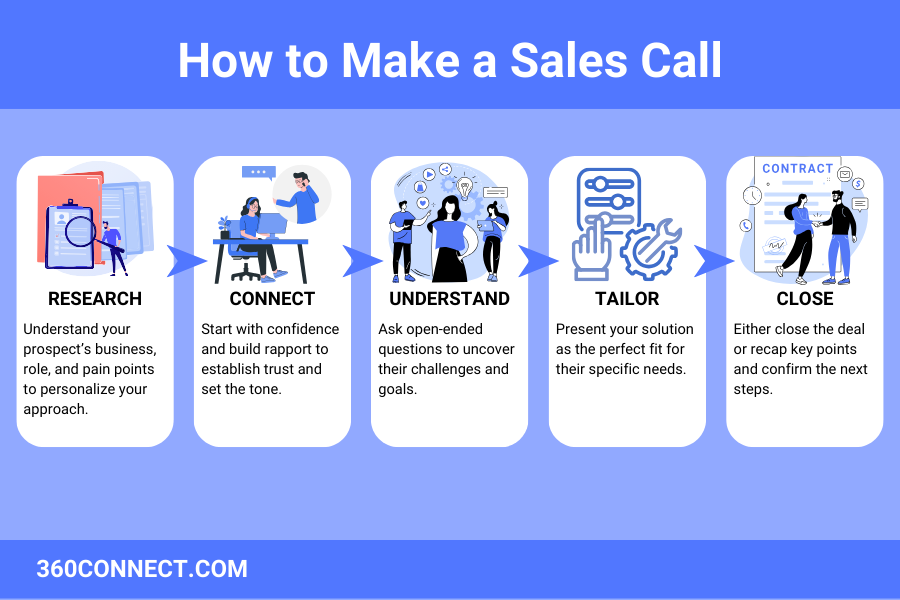Unsure of how to make a sales call? You’re not alone. Many sales agents new and seasoned feel unsure or even intimidated about making the call. However, whether you’re picking up the phone to talk to a brand-new prospect or following up on a previous conversation, it’s a moment that can make or break your sales goals. So it’s pretty important you figure it out. That’s why we’re here to help!
In this guide, we’ll break down everything you need to know—from what a sales call is to tips, scripts, and even a step-by-step look at what a successful call can look like. By the end, you’ll feel confident about how to make a sales call and will be ready to take your sales game to the next level!
What is a Sales Call?
Before we get into how to make a sales call, let’s go over what a sales call is. A sales call is much more than dialing a number and pitching a product—it’s your opportunity to create a genuine conversation with a potential customer. At its core, a sales call is about building trust, understanding the prospect’s unique needs, and showing them how your solution can make their life easier or their business more successful.
Whether you’re making a cold call to introduce your company or a warm call to follow up on a lead, each sales call is a chance to connect and guide the prospect closer to a buying decision. It’s not just about selling—it’s about solving problems and providing value.
How to Prepare for a Sales Call
Although you want to know how to make a sales call, it’s equally, if not more important to prepare for a sales call. Did you know research shows that 40% of B2B sales representatives feel unprepared when they make cold calls? If you want a successful career and to stay employed, you don’t want to be part of that statistic. So let’s help you better prepare for a sales call!
Overall, when it comes to preparing for a sales call don’t overthink it. Instead, think of it like a game plan: the more prepared you are, the more confident and effective you’ll be during the call. Here are the key steps to ensure you’re ready to crush it:
- Research the prospect: Learn about their company, role, and pain points. Check out their website, LinkedIn profile, or any previous interactions.
- Define your objective: What do you want to achieve? Whether it’s scheduling a follow-up, closing a sale, or answering their questions, having a clear goal will keep the call focused.
- Know your product inside and out: Be prepared to confidently explain how your product or service solves their problems.
- Practice active listening skills: Great sales calls are conversations, not monologues. Prepare questions that will encourage the prospect to open up about their challenges.
- Prepare your environment: Make sure your tech is working, you’re in a quiet space, and you have any needed materials (scripts, notes, or a pitch deck) in front of you.
- Double Check Time Zone: Nothing says “unprepared” like calling someone too early or too late in their day. Confirm the time zone when setting up the meeting and double-check it before dialing in.
How to Make a Sales Call
Making a sales call can feel overwhelming, but it doesn’t have to be. Whether you’re new to sales or a seasoned pro, the secret lies in mastering a few key techniques that make your calls more effective and less stressful. These aren’t just surface-level suggestions—they’re actionable strategies that, when done right, can completely transform how you approach sales calls.

The goal is simple: to connect, understand, and deliver value while guiding your prospects toward the next step in their buying journey. But execution matters, and that’s where the following tips come in. Let’s dive into our top tips on how to make a sales call.
How to Make a Sales Call: Top 5 Tips
1. Build Rapport Before Diving In
The first few seconds of a sales call are crucial. This is where the prospect forms their initial impression of you, so it’s essential to start strong. Building rapport is not just about breaking the ice—it’s about creating a connection that makes the conversation feel more personal and less transactional.
One way to do this is by personalizing your approach. Mention something specific about their business, industry, or even their role. Personalization shows that you’ve done your research and care about their unique situation, which sets a positive tone for the call.
It’s also important to convey confidence and enthusiasm without sounding overly rehearsed. Prospects can sense authenticity, and a genuine tone can make them feel more at ease. Remember, the goal here is not to sell right away but to make the other person feel heard and valued.
Finally, keep this part brief. While rapport is important, it’s not the main event. A quick, thoughtful introduction followed by a seamless transition into the purpose of the call ensures you respect their time while establishing a positive dynamic.

Hi [Name], this is [Your Name] from [Company]. I saw that [specific detail about their business], and I have to say, that’s impressive! I wanted to see if there’s a way we can help you build on that momentum.
2. Ask Open-Ended Questions to Understand Their Needs
Effective sales calls are driven by curiosity. Asking open-ended questions encourages prospects to share details about their challenges, goals, and priorities. This not only helps you tailor your pitch but also positions you as someone genuinely interested in helping them succeed.
When crafting your questions, think about what you need to learn to offer a meaningful solution. Avoid yes-or-no questions, as they can lead to dead ends in the conversation. Instead, frame your questions in a way that prompts detailed responses, such as exploring their processes, frustrations, or desired outcomes.
Listening is just as important as asking. When the prospect answers, focus on understanding their perspective. Resist the urge to interrupt or jump in with a solution right away—this part of the call is about gathering information, not selling. Taking notes can also be helpful, as it allows you to reference specific points later in the conversation.
By the end of this stage, you should have a clear picture of what the prospect values and what’s holding them back. This insight is your foundation for presenting a solution that feels personalized and relevant.

What’s something that’s been keeping you up at night when it comes to [specific area]? I’d love to hear what’s been working for you and where you’d like to see things improve.
3. Tailor Your Solution to Their Unique Challenges
Once you understand the prospect’s needs, it’s time to connect the dots. Tailoring your solution is about showing them how your product or service directly addresses their pain points. The more specific you can be, the more impactful your message will feel.
Start by summarizing what you’ve learned. This demonstrates that you were listening and helps build trust. From there, align their challenges with key features or benefits of your offering. Highlight the aspects of your solution that solve their problems or help them achieve their goals.
It’s also important to use language that resonates with the prospect. Avoid technical jargon or buzzwords unless you’re sure they’ll understand. Instead, focus on outcomes—how your solution will save them time, reduce costs, or improve efficiency. Prospects are more likely to engage when they see a clear, tangible benefit.
Tailoring your pitch shows that you’re not just making a generic sales call but are invested in solving their unique problem. This personalized approach not only increases the likelihood of a positive response but also builds credibility and trust.

You mentioned that [specific pain point] has been frustrating. I completely get that—it’s a challenge we hear often. What we’ve found works really well is [specific solution], which has helped businesses like yours achieve [specific result].
4. Handle Objections with Confidence and Empathy
Most of the timidness when it comes to making a sales call is hearing a no. Well, about 60% of customers reject offers four times before they finally accept them. So, once you accept objections and rejections are part of the job, the more at ease you’ll be to get through to the client during the call.
Objections are inevitable, but how you handle them can make or break the call. Instead of viewing objections as roadblocks, see them as opportunities to address concerns and strengthen your pitch. Confidence and empathy are your greatest assets here.
When a prospect raises an objection, start by acknowledging their concern. This validates their perspective and shows that you’re listening. Jumping straight into a rebuttal can come across as dismissive, so take a moment to empathize before offering a solution.
Finally, position your response in a way that reframes the objection as a benefit. This isn’t about being pushy—it’s about helping the prospect see the value in your solution. When done well, objection handling can turn skeptics into believers. And while you still may get a “not right now”, you are moving the conversation closer to a successful outcome down the road.

I hear you—[objection] is something a lot of people are concerned about. What might help is knowing how others in your position have found [specific benefit] to outweigh that worry. Let’s talk through how it might work for you.
Related: 6 Tips to Overcome Sales Call Reluctance
5. End the Call with a Clear Next Step
The end of a sales call is just as important as the beginning. Without a clear next step, even the best conversation can lose momentum. Your job is to guide the prospect toward a specific action that keeps the ball rolling.
Start by summarizing the key points discussed during the call. This reinforces the value of the conversation and ensures you’re both on the same page. From there, propose a next step that aligns with their needs and the stage of the sales process they’re in.
Be specific and proactive. Vague follow-ups like “I’ll send you some information” lack urgency and can easily be forgotten. Instead, suggest a concrete action with a clear timeline, such as scheduling a demo, sending a proposal, or setting up a follow-up call.
Finally, express gratitude for their time and end the call on a positive note. Leaving a good impression increases the likelihood of them engaging with you again and sets the stage for a productive follow-up.

Let’s set up a quick walkthrough of [specific product/service] so you can see exactly how it works for your needs. How does [specific date and time] sound?
How to Make a Sales Call: Easy Steps
If we threw too much info your way, here’s a simplified version:
- Step 1: Research—Learn about your prospect’s company, role, and challenges to personalize your approach.
- Step 2: Pick up the phone (or hop on Zoom)—take that first step.
- Step 3: Greet the prospect—start with energy and confidence.
- Step 4: Ask questions—get them talking about their needs.
- Step 5: Pitch your solution—explain how you can help.
- Step 6: Address concerns—listen and respond thoughtfully.
- Step 7: Close the call—recap and confirm the next step.
It’s really that simple when you break it down!
Why You Need a Sales Call Script
You have the steps and tips, and you’re almost ready to get started but there’s one secret weapon you’ll want to fine-tune: a sales call script. When used correctly, a sales call script can make your conversation efficient, keep you on track, and increase conversions.
Overall, sales call scripts are great for helping train new salespeople by providing a guide to follow and can help seasoned agents remain focused. However, an important thing to note is that sales call scripts should be used as guides, NOT to be read word-for-word. A sales call script should be used in combination with the tips and steps we’ve gone over already.
Remember, scripts are your best friend—but only if you use them wisely. Here’s how to make scripts work for you:
- Keep it conversational: Don’t read your script word-for-word. Use it as a guide to stay on track.
- Focus on key points: Your script should include an introduction, discovery questions, your value proposition, and a strong call to action.
- Practice makes perfect: The more you rehearse, the more natural you’ll sound. Record yourself or role-play with a colleague to build confidence.
- Adapt in the moment: Be flexible. If the prospect takes the conversation in a new direction, go with it while keeping your end goal in mind.
- Keep it Timely: Respect the prospect’s time and your own by staying concise and focused. Avoid unnecessary tangents, and aim to wrap up the call within 5 to 15 minutes. Furthermore, you should also call them while your solutions are still on their mind.
Final Thoughts on How to Make a Sales Call
Sales calls don’t have to feel intimidating. With preparation, practice, and the right approach, you can turn them into one of your most effective tools for building relationships and closing deals. Remember, every call is a learning opportunity, so don’t be afraid to make mistakes or adjust your strategy as you go.
Take a deep breath, pick up the phone, and remember: you’re not just selling—you’re solving problems and building trust.
Get Quality Leads for Your Sales Calls
Great sales calls start with great leads. If you’re tired of cold calling prospects who aren’t a good fit, it’s time to upgrade your strategy. At 360Connect, we connect you with verified, high-quality leads that are actively searching for solutions you offer.
Ready to take your sales calls to the next level? Get started with 360Connect today and see the difference for yourself!

